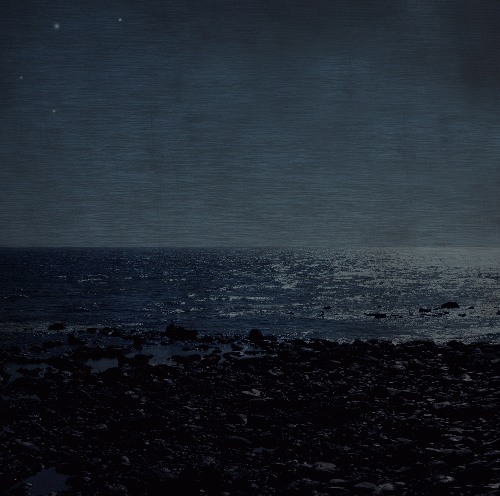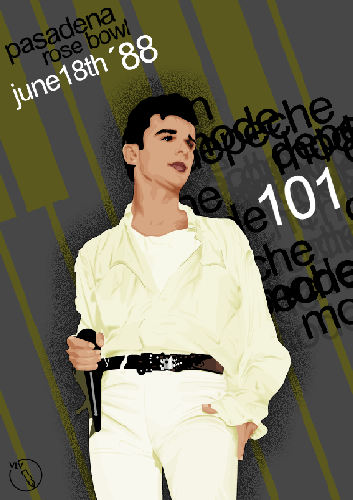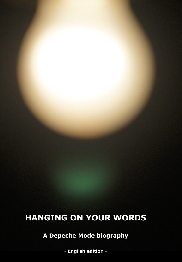1988
The third leg of the Masses-Tour began on 9 January, comprised
11 concerts in the UK, and ended on 24 January.
Directly afterwards, on 25 January, Hydrology was released,
a kind of Recoil album with three long instrumental pieces, Grain, Stone
and The Sermon, to which 1+2 were added.
Alan: "Hydrology was a step up from 1+2. It was done on
a half-inch 16-track Fostex machine. So there were limitations, but it was
much more versatile than the first thing I had done. Recoil was still very
much an aside to Depeche Mode, with no pressure or expectations placed upon
it. It was always going to be an 'antidote' to Depeche Mode in some ways; a way
to alleviate the frustrations of always working within a pop format. I have
nothing against the pop format, but if I was going to do something on my own,
there was no point in repeating what I was already doing in the group. It was
intended to be completely different and experimental. It didn't matter if it
was too left-field or too weird for people.[1]
Naive as they sound to me now, 1+2 and Hydrology still say
something about the idea behind Recoil and how the music is constructed.
From that perspective, they are still interesting.
The artwork was conceived by Martyn Atkins and the choice of images was
down to his interpretation of the music. I thought they fitted well."[2]
While I never got any answer according to the question if I might stream excerpts
of Depeche-Mode-songs on this website, Alan kindly granted me to do so with
Recoil-songs.
So here is an excerpt of Grain:
(with friendly permission of © Recoil / Alan Wilder)
From 6 February to 13 March the second European leg of the Masses-Tour
took place, comprising 25 concerts. In this period the legendary gig in
East-Berlin also took place, on 7 March. DM had played some gigs in the
Eastern Bloc before - mainly in Hungary - but they had never had the chance to play
in East Germany.
Fletch: "We really wanted to play in East-Berlin, but we never were allowed
to. And one day it finally worked! We knew we had a massive fan-base in East
Germany: from letters, from friends in West-Berlin, from the media. We were told
we were bigger there than the Beatles. Later we were told that we were used as
some kind of propaganda. We heard that normal fans had no real chance to get a
ticket. We didn't know this, we just were keen to play in East-Berlin. Today
I would say it would have been better not have to played that gig. Nevertheless,
it was a great gig - but it was also frustrating. Fans met somewhere but couldn't
come closer to us. We hadn't known much about our fans in East Germany before
the gig and, unfortunately, we didn't know much about them afterwards."[3]
The interest in "western bands" in general was much stronger in the Eastern Bloc
than in the "western world", maybe because it was difficult to get their LPs,
and of course almost impossible to see them live, because they weren't "invited"
to play there.
Socialist regimes had specific ideas about which kind of culture should be available
to the youth of the nation. But in 1988 most of the regimes in the Eastern
Bloc were already in trouble, and here and there they opened up a bit, maybe to
give the impression of being cosmopolitan, and to distract the young people from
the growing problems.
However, not everyone could get a ticket. The tickets were mainly given to leaders
of organisations, and they would give them to those who had a "blameless lifestyle".
Some reports say that there had been a lot of police, and it was difficult to get
closer, others say that it wasn't that difficult. But probably the venue was
pretty well sealed off.

The fifth and last leg of the tour started on 18 April in Tokyo,
comprising four gigs in Japan and 31 in the U.S.
At this leg the band was accompanied by the film director Pennebaker who filmed
them and a group of teenagers on this "roadtrip".
The film mainly shows the start of the massive success of DM in the U.S.
Alan: "The band had toured constantly in America and battled against
a radio-play brick wall for many years until suddenly things started to happen.
Of course, it was an important and exciting time for us in the U.S. and we
wanted to concentrate on this territory."
Only in L.A. things had been a bit different.
"DM has a massive following in the LA area which (more than anything else)
is probably down to one radio station - KROQ. Of course, since 1986 or so,
the band have worked that area very hard to capitalise on that success but
Richard Blade and co. have been staunch supporters of the band for many years."[4]
Fletch: "No-one believed an alternative band could play to so many people.
And again that set the ball rolling for a lot of bands after us. We were
conquering the world."[5]
Dave: "After that film came out, suddenly we were this 'stadium band',
which wasn't actually true - we'd played one stadium - but the perception
really changed. We started to get bigger than I'd ever imagined we'd be."[6]
I think they really felt like that, like conquering the world, and therefore
the speculation in some of the media at that time that they might split up or
crack up seemed almost ridiculous, although there was high tension within the band.
Dave's drug problems had already increased during this tour. His drug of choice
at this time was cocaine. It was noticed by the other band members, but they
didn't react to it. So obviously drugs weren't unknown to them or they didn't
know enough about the consequences, otherwise they would have been alarmed.
At that time Dave also met Theresa [his future second wife], which was to have
serious consequences later.
According to rumours things didn't run as smoothly as shown in the tour-film 101,
in which Jo and the baby also appeared.
There was even one rumour saying that the tensions within the band had led to a
fistfight between Fletch and Alan. This is what they said about it between the lines:
Dave: "When you come offstage the tension is very high, you're on
an emotional high but also you can get at each other. A couple of members
of the band have come to blows just because of, maybe that's just because
someone's not playing their part properly. And it's so extreme and you're so
hyped up and you come offstage, and basically anyone gets it if they're
in the way. And a couple of times there've been fights - actually real -
they've been broken up and we've had to go back onstage to do an encore.
I think you sense a lot of the time in the film when there's real tension
in the band and possibly not getting on with each other, but then there's
other times when ..."[7]
When I had the opportunity to ask Alan whether there
had been a fight or not, he said, "Yes, there was an
altercation post-gig concerning Fletch's comments about
Dave's performance during the show - which I felt were rather
rich in light of his own contribution."[8]

(Stjarna - with friendly permission of © Karen - °°k°°)
Little 15 / Stjarna / Sonata No.14 (Moonlightsonata) was the last single
release, although it wasn't released everywhere. It was released on 16 May.
There weren't any remixes of Little 15 available. Stjarna is an
instrumental track written by Martin, but performed by Alan on the piano.
Sonata No.14 is a piece of Ludwig van Beethoven, an unusual choice
for a pop band. It was Martin who had the idea to put it out as a B-side,
and it was Alan who interpreted it on the piano. At that time he was obviously
practising the piano regularly, and was very interested in composers like
Philip Glass, who combine classical and modern music.
About Little 15 Alan said that it
"was never intended as a single - in fact from the outset, it was touch and
go as to whether the track would even be recorded at all. However, encouraged
by Dan Miller, an experimental approach in the studio gave rise to a simple
ballad based around a Nyman-esque opening string arrangement. It was the French
record company who later insisted the song was perfect for their market,
resulting in a release geared towards this territory only."[9]
Ironically, Little 15 didn't chart in France, but when it was released
in other countries as well it finally became a success.
The video for Little 15 was directed by Martyn Atkins, but it fits well
in the way of the Anton Corbijn-videos with its black and white image and
narrative or implied story-line.

In the course of time Alan answered a lot of questions about touring
with DM while he was a member. Taking all his answers together, it gives a
good insight into the "tour-machinery" of the band.
Even at the time of the Masses-Tour, DM had "a crew of a couple of
hundred people to take care of"
all kinds of things that were needed on tour. But some of the planning they
still did themselves together with "our agent and Jonathan. Between us all, (taking
into account many factors) we would decide which countries and cities to play
and when. Once we had a general plan, the specific routing would be optimised,
again depending on travel times, venue availability, local promoter advice,
record release dates and other logistical considerations etc."
For the backing-tapes they used "two identical machines which ran in sync -
one was purely a back-up to the other in case of breakdown. The machines would
be started by the keyboard tech., Wob Roberts, at the beginning of the set
and were only stopped and re-started inbetween encores."
Alan was responsible for re-working the tracks, so they could be used as
different live performance. "There are many subtle differences one would
apply depending on the nature of the track, what you're trying to achieve
with it, and where it comes in the set etc. Generally, live versions can take
more dynamic contrast, longer dance sections and a big ending!"
He usually worked out "8 separate tapes - basically 4 different set-lists
(red, green, blue and yellow I think) which were each split into two halves
and broken up by an acoustic song somewhere in the middle - which allowed for
the tape change. Effectively therefore, we could mix and match any combination
of 1st and 2nd half tapes. Along with a few different alternatives for Martin's
acoustic songs, this gave us the opportunity to perform many different
running orders although all of them had the same overall shape and structure.
So, for example, a quick chat beforehand might result in 'let's play the
blue / red set tonight with Somebody instead of I Want You Now
in the middle.' We could also change tapes for the encores, if necessary."
They also started to change their appearance on stage, began to use guitars and
other instruments because they thought
it would add something "to the dynamics of the show as well as giving Martin and myself
an opportunity to move away from standing behind keyboards all the time.
As DM's popularity increased, it was necessary for the music and shows to
grow - it would have looked pretty ridiculous to have 4 blokes bleeping away
on little synthesisers in a massive stadium."
About 50% of the music was played live while the rest was pre-recorded
music. "Our policy was to always play as much as we could manage (without
bringing in lots of extra musicians). For me, I can't stand being on stage
with nothing to do. I would feel uncomfortable, so I always gave myself plenty
of parts to play. I liked the challenge of having to remember lots of things.
There were no special rules" about who had to play which musical parts. "It was
a question of logistics. I would just spread the sounds over the two
keyboards [Martin's and mine] as conveniently as possible."[10]
It's remarkable that he left Fletch out and was talking about using only TWO
keyboards. I assumed it was some kind of mocking remark because he wrote this
many years later, but I found an article from 1988 in which he also
spoke about using just two keyboards.
"I divide all important melodies among Martin and myself, so we
don't have to program anything for those. Most of the time we use an E-Max Emulator.
We split the keyboard in six parts so we can play 6 sounds at one time."[11]
It was also quite easy to choose the positions on stage. "Being short with a
bizarre appearance, Martin always seemed to look better in the middle. I
always chose the position nearest the monitor desk for communication with
the sound engineer." From the mixing board, there were always
recorded some "rehearsals and the first few shows of a tour. These don't
always give you an accurate balance but are good for checking performance etc."
For other bands it has never been easy to open for DM. "Daniel always tried to
encourage Mute bands for obvious reasons but we would consider anyone who
seemed to vaguely fit the bill. As always, everybody had different opinions
as to who was most suitable. I must admit, it wasn't something that I felt
very strongly about so Martin or Dave usually had final say."
One of the opening acts for the Masses-Tour was Nitzer Ebb. Several collaborations
date from these days, especially between Alan and Douglas McCarthy, the singer
of Nitzer Ebb.[12]

(with friendly permission of © Anja - compositionofsound)
The tour ended on 18 June with the legendary 101st concert in the
Rosebowl of Pasadena, California. It became the band's biggest success so far,
and was described by the band members as one of the greatest moments of their
career, but not as their best performance.
Alan: "The Rosebowl performance wasn't actually one of the best
due to monitoring problems but it certainly gave us a lot of credibility
back in Europe where nobody could quite believe our popularity in the States."[13]
Fletch: "It was a turning point for us in the U.S. and in alternate music."[14]
Dave: "When the curtain goes down and you see that amount of people
going crazy it's very, you know, lump in the throat stuff. Towards the end
of the concert it got so emotional that I actually found myself having
trouble singing. That sounds probably a bit twee - but it was really like
that. And I went backstage afterwards and just felt really upset that it
was all over."[15]
All band members would recall Rosebowl as their highest point and best memory
for a long time. It was obviously difficult for them to move onwards from this
point. Especially Dave, who was getting more and more into trouble, had the
feeling that not much could come afterwards. He thought that they just couldn't
climb any higher.
During this last leg of the Masses-Tour, a tradition was founded that has survived
until today - fans waving their arms in the air during the end of
Never Let Me Down Again. It wasn't "developed" at the Rosebowl as such,
but had happened before, but of course the Rosebowl concert was filmed, and the
picture of all these people waving their arms was a very impressive one.
The number 101 also became a symbol for DM-fans worldwide. Many of the "die hard"
fans still try to get a number plate / hotel room / flat / house with number 101 on it.
On 12 July Strange was released, a video collection with mainly Corbijn-videos that was important for the image of the band. For the rest of the year they finally got some time off.
References:
[1] Unsound Recordings, Sound On Sound, January 1998. Words: Bill Bruce
[2] www.recoil.co.uk
[3] FR Online.de, 1 November 2009. Words: Nadja Erb / Steven Geyer
[4] www.recoil.co.uk
[5] Just Can't Get Enough, Uncut, May 2001. Words: Stephen Dalton
[6] Many Smack-Free Returns! Q, June 2001. Words: Dorian Lynskey
[7] In Movie Mode, "TV-AM", ITV, February 1989
[8] Depechemodebiographie.de
[9] www.recoil.co.uk
[10] www.recoil.co.uk
[11] The Jagger Reports - Interview with Alan Wilder, Backstage, April 1988. Words: Chris Jagger.
[12] www.recoil.co.uk
[13] www.recoil.co.uk
[14] Masters Of Their Universe, The Times, May 3rd 2009, author unknown
[15] In Movie Mode, "TV-AM", ITV, February 1989

 BIOGRAPHY
BIOGRAPHY